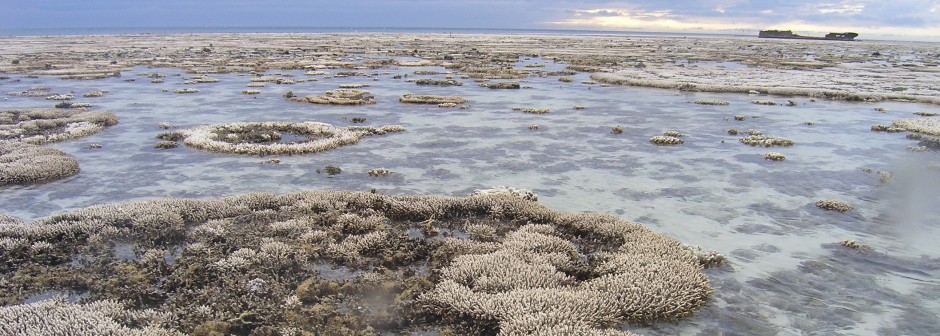When situated near coral reefs, mangroves affect the reef communities in many interesting ways. Mangroves are trees that can grow in environments with poor oxygen content. Mangroves can grow in fresh, brackish, and salt water. The term ‘mangrove’ does not actually refer to a specific taxonomic grouping; rather, it refers to the group of plants that can survive in such tough conditions. There are seven types of mangroves, but the three most common species of mangroves are the red, white, and black mangroves. Personally, the red mangrove (Rhizophoramangle) is what I picture when I think of a mangrove (see image). Red mangroves have easily identifiable large tangled root systems. Mangroves serve as shoreline protection, and, when situated near reefs, as nurseries for many species of reef fish.

Red mangroves. Note the complex root system which is integral to their efficacy as a nursery habitat. (credit http://www.reelfl.org/wp-content/uploads/2014/10/Red-mangrove.png)
Only thirty five percent of coral reefs have mangroves nearby. Therefore, mangroves clearly are not necessary for reef ecosystems’ success. It is estimated that there is only a 6-8% chance that a larval fish, when spawned on a random reef, will find a coral reef with a mangrove close by.(1) However, reefs that are situated near mangroves can have increased biomasses of over 162 fish species. These include herbivores, invertivores, and piscavores.(2) For example, it was found that the Scarus iseri species of parrotfish had significantly higher biomass on reefs with mangroves nearby and that the Scarus guacamaia species of parrotfish’s juveniles depended on mangroves for survival.(3) Interestingly, some species’ biomasses decrease on reefs near mangroves. This is probably because their predators use the mangroves and thus are present in higher numbers.(4) An example of a species that would probably suffer as a result of nearby mangroves would be the macroalgae grazed on by the parrotfish species that benefit from the presence of mangroves.
View underwater of the mangroves root system (credit https://lh3.googleusercontent.com/1s3bSP0A14P4-dT7An8fwhbA4-wCP7ERffVfC1yC8JXmGwF5_BqnD7JHmZvmoc28g6kmrZbZhbX4LUlsRrEeVpwnbp3PLo-6WjVZqftjGr_zWBENxzhgxDAjUXuPUgc4bb5PBCM)
Most reef fish that use the mangrove habitat do so as juveniles. Fish oftentimes will use different habitats at different stages of their lives. Some reasons for this include changes in food requirements with age and changing risks of predation as the fish grow.Some use the mangroves as a nursery habitat, and others use it as an intermediate habitat between seagrasses, where they spend their juvenile stage, and the reef, where they will spend their adult stage.(5) A nursery is defined as a “habitat for a particular species that contributes a greater than average number of individuals to the adult population on a per-unit-area basis in comparison to other habitats used by juveniles.”(6) Mangroves make a good nursery habitat because there is lots of food available. Also there is a decreased predation risk within the mangrove roots because, as seen in the above image, they live in shallow water and because the complex, maze-like structure provides many hiding places. Another cause for the decreased predation risk is high turbidity and poor visibility within the mangrove roots.(7)
Another majorly important function of mangroves near reefs is shoreline protection. Mangroves were found to be more effective than the coral reefs at decreasing wave energy. Mangroves are able to reduce non-storm waves by 70% of their near shore height!(8) They are also very effective at diminishing storm waves. Additionally, mangroves can slow erosion and soil loss from the shoreline due to the frictional drag that their roots apply to the water column.(9) In this way, they also can protect reefs from the shoreline, as sediment and nutrient run off can be very damaging to reefs. Obviously, people are more inclined to care about mangroves for their function in protecting our own environments rather than their role on reefs. Just last week, the Jamaican government dedicated additional funds to rehabilitate mangrove habitats in order to better protect their suffering shoreline (see image).(10)

The eroding Jamaican shoreline, which officials hope to improve through mangrove rehabilitation. (credit http://cdn4.antiguaobserver.com/wp-content/uploads/2017/02/Palisadoes-2.jpg?x54148)
For several reasons, mangroves should be important to us all.
Footnotes:
1: Brown et. al, “Uniting paradigms of connectivity in marine ecology.” Ecology. 97, 9, 2016, pp. 2447-2457.
2:Peter Mumby, “Connectivity of reef fish between mangroves and coral reefs: ALgorithms for the design of marine reserves at seascape scales.” Biological Conservation. 28, 2006, pp. 215-222.
3:Harborne et. al, “Direct and indirect effects of nursery habitats on coral-reef fish assemblages, grazing pressure and benthic dynamics.” Oikois. 125, 2016, pp. 957-967.
4: Brown et. al
5: Mumby
6:Lee et. al, “Ecological role and services of tropical mangrove ecosystems: a reassessment.” Global Ecology and Biogeography, 23, 2016, pp. 726-743.
7: Lee et. al
8:Guannel et. al, “The Power of THree: Coral Reefs, Seagrasses and Mangroves Protect Coastal Regions and Increase Their Resilience.” Plos One. 11, 7,2016.
9: Guannel et. al
10: http://antiguaobserver.com/government-allocates-funds-to-monitor-mangrove-rehabilitation/

